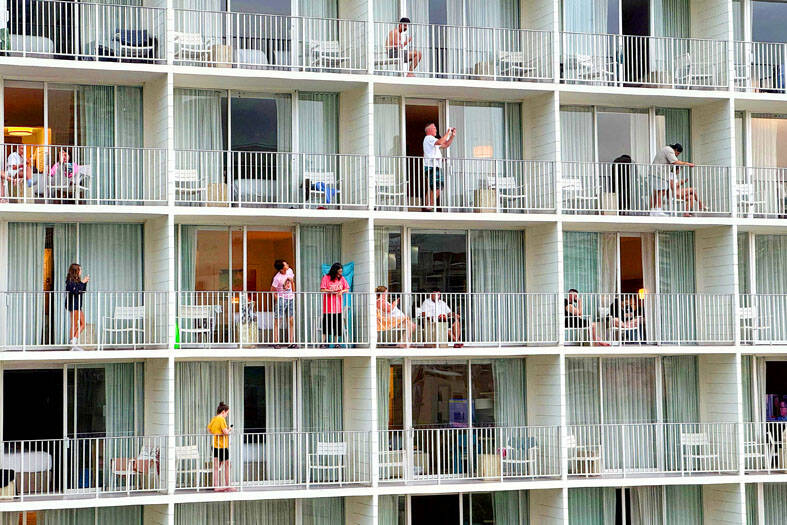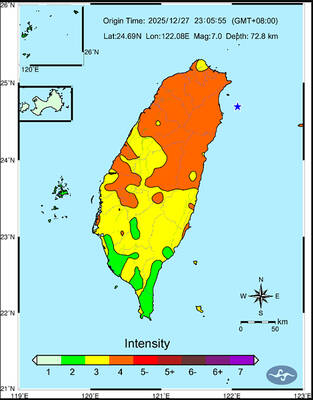One of the strongest earthquakes ever recorded yesterday struck Russia’s sparsely populated far east, causing tsunamis up to 4m high across the Pacific and sparking evacuations from Hawaii to Japan, with warnings of up to 1m waves in Taiwan.
The magnitude 8.8 quake, which struck off Petropavlovsk on Russia’s Kamchatka Peninsula, was the largest since 2011 when a magnitude 9.1 quake off Japan caused a tsunami that killed more than 15,000 people.
Almost 2 million people in Japan were told to head to higher ground and tsunami warnings were issued across the region, before being rescinded or downgraded — although scientists warned of the danger of powerful aftershocks.

Photo: Geophysical Service of the Russian Academy of Sciences via AFP
A tsunami had already hit and flooded the port town of Severo-Kurilsk, crashing through the port area and submerging the local fishing plant, officials said.
Russian state television footage showed it sweep buildings and debris into the sea.
Authorities said the population of about 2,000 people had been evacuated.

Photo: Russian Ministry of Emergency Situations via AFP
The waves reached as far as the town’s World War II monument about 400m from the shoreline, Severo-Kurilsk Mayor Alexander Ovsyannikov said.
Several people were injured in Russia by the quake, state media reported, but none seriously.
“The walls were shaking,” a Kamchatka resident told state media Zvezda.

Photo: Reuters
“It’s good that we packed a suitcase, there was one with water and clothes near the door. We quickly grabbed it and ran out... It was very scary,” she said.
Later yesterday, authorities in the Kamchatka Peninsula announced that the tsunami warning had been lifted.
Officials from countries with a Pacific coastline in North and South America — including the US, Mexico, Ecuador and Colombia — issued warnings to avoid threatened beaches and low-lying areas.
In Hawaii, Governor Josh Green said flights in and out of the island of Maui had been canceled as a precaution.
The Pacific Tsunami Warning Center later downgraded the alert for Hawaii to an advisory and local authorities canceled a coastal evacuation order.
Earlier, tsunami sirens blared near Hawaii’s popular Waikiki surf beach where traffic was gridlocked as Hawaiians escaped to higher ground.
“STAY STRONG AND STAY SAFE!” US President Donald Trump wrote on social media.
Yesterday’s quake was the strongest in the Kamchatka region since 1952, the regional seismic monitoring service said, warning of aftershocks of up to magnitude 7.5.
The epicenter was in about the same location as the magnitude 9.0 quake that year that caused a Pacific-wide tsunami, the US Geological Survey said.
Yesterday’s quake was one of the 10 strongest earthquakes ever recorded, the organization said.
The quake was followed by at least six aftershocks that further rattled the Russia’s far east, including one of magnitude 6.9.
The US Tsunami Warning Centers said waves exceeding 3m above the tide level were possible along some coasts of Ecuador, northwestern Hawaiian islands and Russia.
Between 1m and 3m waves were possible along some coasts of Chile, Costa Rica, French Polynesia, Hawaii, Japan and other islands in the Pacific, it added.
Waves of up to 1m were possible elsewhere, including Taiwan, Australia, Colombia, Mexico, New Zealand and Tonga.
In Taitung, hotel resort worker Wilson Wang, 31, said: “We’ve advised guests to stay safe and not go out, and to avoid going to the coast.”

A magnitude 7.0 earthquake struck off Yilan at 11:05pm yesterday, the Central Weather Administration (CWA) said. The epicenter was located at sea, about 32.3km east of Yilan County Hall, at a depth of 72.8km, CWA data showed There were no immediate reports of damage. The intensity of the quake, which gauges the actual effect of a seismic event, measured 4 in Yilan County area on Taiwan’s seven-tier intensity scale, the data showed. It measured 4 in other parts of eastern, northern and central Taiwan as well as Tainan, and 3 in Kaohsiung and Pingtung County, and 2 in Lienchiang and Penghu counties and 1

FOREIGN INTERFERENCE: Beijing would likely intensify public opinion warfare in next year’s local elections to prevent Lai from getting re-elected, the ‘Yomiuri Shimbun’ said Internal documents from a Chinese artificial intelligence (AI) company indicated that China has been using the technology to intervene in foreign elections, including propaganda targeting Taiwan’s local elections next year and presidential elections in 2028, a Japanese newspaper reported yesterday. The Institute of National Security of Vanderbilt University obtained nearly 400 pages of documents from GoLaxy, a company with ties to the Chinese government, and found evidence that it had apparently deployed sophisticated, AI-driven propaganda campaigns in Hong Kong and Taiwan to shape public opinion, the Yomiuri Shimbun reported. GoLaxy provides insights, situation analysis and public opinion-shaping technology by conducting network surveillance

Taiwan is gearing up to celebrate the New Year at events across the country, headlined by the annual countdown and Taipei 101 fireworks display at midnight. Many of the events are to be livesteamed online. See below for lineups and links: Taipei Taipei’s New Year’s Party 2026 is to begin at 7pm and run until 1am, with the theme “Sailing to the Future.” South Korean girl group KARA is headlining the concert at Taipei City Hall Plaza, with additional performances by Amber An (安心亞), Nick Chou (周湯豪), hip-hop trio Nine One One (玖壹壹), Bii (畢書盡), girl group Genblue (幻藍小熊) and more. The festivities are to

AFTERMATH: The Taipei City Government said it received 39 minor incident reports including gas leaks, water leaks and outages, and a damaged traffic signal A magnitude 7.0 earthquake struck off Taiwan’s northeastern coast late on Saturday, producing only two major aftershocks as of yesterday noon, the Central Weather Administration (CWA) said. The limited aftershocks contrast with last year’s major earthquake in Hualien County, as Saturday’s earthquake occurred at a greater depth in a subduction zone. Saturday’s earthquake struck at 11:05pm, with its hypocenter about 32.3km east of Yilan County Hall, at a depth of 72.8km. Shaking was felt in 17 administrative regions north of Tainan and in eastern Taiwan, reaching intensity level 4 on Taiwan’s seven-tier seismic scale, the CWA said. In Hualien, the